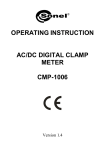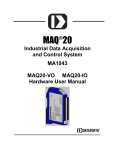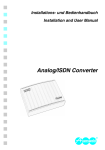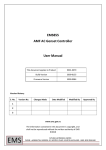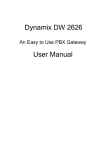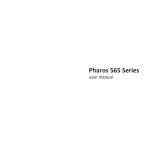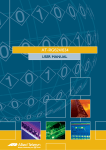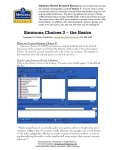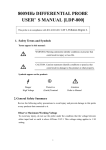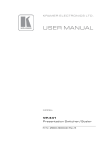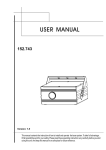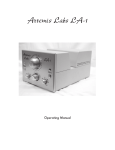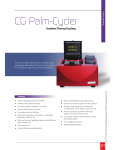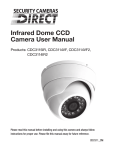Download Quest ISDN Plus Manual
Transcript
Quest - ISDN NT 1 Plus ISDN Plus NT-810 www.pharos.com.eg 1 Quest - ISDN NT 1 Plus User’s manual 2 Quest - ISDN NT 1 Plus Index 1 2 3 4 5 6 7 8 9 10 11 Introduction…………………………………………..…. Product features……………………………………...… Quest hardware installations………………………….. Meaning of the LEDs Indications…………………...… Selection of the terminal resistance………………….. Remote power feeding selection…………………...… System Programming…………………………………. Usage • • • • Intercom……………………………………… Call transfer internally…………………….... 3PTY (Three Party Service)……………..… CW (Call Waiting)………………………..…. Specifications………………………………………….. FAQ…………………………………………………….. Appendix: Bus of ISDN BRI S/T-interface • Point to point configuration………………… • short passive bus configuration…………… • Extended passive bus configuration……… • Length of the connected wire……………… • Polarity………………………………………. • Accessible number………………….……… 3 2 3 5 6 7 7 8 11 11 11 12 13 15 17 17 18 18 18 19 Quest - ISDN NT 1 Plus Introduction Quest ISDN NT 1 Plus supplies 2-wire bi-directional transferring ability of 2B+D. It also supplied 2 POTS, provides high-quality Internet access and data transmission service and dials up to Internet via ISDN network with a high-speed data rate of 64kbps and 128kbps. It can automatically detect and configure resources, and support current popular Internet access software including Netscape and Internet Explorer. ISDN has a good connection feature and can be connected with many networks such as telephone network, packet switching network, Internet and local area network, etc. 4 Quest - ISDN NT 1 Plus Product Feature ·Power saving enabled sleep state to save power while TE does not work. ·Low power design, satisfies 1.5w and the target of the remote power. ·One analog phone or one ISDN phone can work in the case of power failure. ·Keeps the link status while switching between local power and remote power, and the switching is automatic. ·Has cold start and warm start, and fixed timer and self-adapt timer. ·Supports CAPI 2.0 ·Support Reverse Polarity for analog ports (for call metering). ·Accesses 8 terminals in the case of point to multi-points. ·U-interface supports long distance transfer, it possesses strong anti-jamming ability. ·Directly accesses analog services such as ordinary phone,G3 fax, modem, etc. ·Call restriction function. 5 Quest - ISDN NT 1 Plus ·Supports supplementary services such as MSN (Multiple Subscriber Number), SUB (sub address), CW (Call Waiting), 3PTY(Three Party Service), etc. ·A or μ law selectable by POTS. ·Supports caller ID,FSK type Ⅰ or DTMF mode selectable by POTS. ·Very strong compatibility: supports various switchers ·Supports RVS-COM ISDN application packets ·High cost-effective, fast date rate, up to 128kbps for accessing Internet ·Supports all applications used for accessing Internet (www browser, FTP, Email, etc.) ·Uses message driven mechanism, featuring real-time and multi-task. ·Powered by Pharos Firmware which develop, debug and test platform, it has the ability to simulate interactive between command and data in high-layer application and test operation situation for low-layer system. ·Complies with international and national standards ·High integrity circuit and stable quality 6 Quest - ISDN NT 1 Plus Quest hardware installations 1. Insert the S/T plug of TE1 (eg. ISDN phone) into S/T1 or S/T2, or insert the plug of an analog phone into TEL1 or TEL2. 2. Insert the U-plug into the U-interface embedded in the wall. 3. Switch on the power. 4. Send activation command from TE1 (eg. hook off an ISDN phone) or TA (eg. hook off an analog phone) or from LE (call this ISDN number), now, the status LED flash at 8Hz. 5. After several seconds, the status LED turns ON (U- and S/T- interfaces work normally),or flashes at 1Hz(U-interface works normally, S/T-interface works abnormally),or turns OFF(U-interface works abnormally). Back connections layout: Power port U port ST1 port ST 2 TEL 2 Choice of feeding in remote status 7 TEL 1 port USB Quest - ISDN NT 1 Plus Meanings of the LEDs Indicators 1. Status LED OFF: U- and S- interfaces not activated. Flashes at 8Hz: Activating the U-interface or U-interface fault. Flashes at 1Hz: U-interface activated, S-interface being activated or S-interface fault ON: U- and S-interface all activated 2. Remote power LED (R-Power LED) 3. Local power LED (L-Power LED) PWR LED Local power (L-Power LED) & Remote power (R-Power LED) local power provided: Local power ON, Remote power OFF local power not provided:. Local power OFF, Remote power ON 4. TEL LED 1 OFF: Flashes at 8Hz: ringing. Flashes at 1Hz: POTS being used. ON: 5. POTS idle. talk TEL LED 2 (same as TEL LED 1). 8 Quest - ISDN NT 1 Plus Selection of the terminal resistance If the 50Ω resistance is needed, you can find JP6 jumper while you open the NT1 plus, short the pin 1-2 and pin 3-4. S S 1 2· 3 4 JP6 Remote power feeding selection In case of restricted power supply, you can select only one analog phone or one ISDN phone to work by set the jumper back of the device, short 3-4 pin to select one analog phone, or short 1-2 pin to select one ISDN phone. ST 1··3 TEL2 9 Quest - ISDN NT 1 Plus System Programming 1.System Programming Hook off any analog phone, you will listen dial tone, then, press the ‘**’ keys, the dial tone disappears, now, dial a digit string started with ‘*’ and ended with ‘#’ to program as listen in the following table. Function Usage Configure MSN Cancel MSN Configure sub address *90*old PIN*new PIN* new PIN# *91*PIN*MSN# *91*PIN# *92*PIN*SUB# Cancel sub address *92*PIN# Change Pin Code Connected Line Identification Presentation Connected Line Identification Restriction Calling Line Identification Presentation Calling Line Identification Restriction A law μ law Configure point to multi-points or extended passive bus Configure short passive bus Reject waiting incoming call while POTS all idle Receive waiting incoming call while POTS all idle Caller ID : FSK type I Caller ID : DTMF *93*PIN*2# *93*PIN*3# *93*PIN*0# *93*PIN*1# *93*PIN*4# *93*PIN*5# *93*PIN*6# *93*PIN*7# *93*PIN*8# *93*PIN*9# *94*PIN*0# *94*PIN*1# 10 Notes Default Pin ‘000’ initial setup:’1’ for POTS 1,’2’ for POTS 2 Quest - ISDN NT 1 Plus Don’t add ‘0’ in front of the number of long distance incoming call Add ‘0’ in front of the number of long distance incoming call Enable Reverse Polarity Disable Reverse Polarity *94*PIN*2# *94*PIN*3# *94*PIN*4# *94*PIN*5# Adjust the receiving volume *95*PIN*0|12|3|4# Adjust the transmitting volume *96*PIN*0|12|3|4# Configure 10 outgoing restricted numbers Cancel outgoing 10 restricted numbers Configure incoming restricted numbers Cancel incoming restricted numbers Configure outgoing emergent numbers Cancel outgoing emergent numbers Configure incoming important numbers Cancel incoming important numbers call restriction mode no call restriction *50*PIN*number0# *59*PIN*number9# *50*PIN# *59*PIN# *40*PIN*number0# *49*PIN*number9# *40*PIN# *49*PIN# *60*PIN*number0# *69*PIN*number9# *60*PIN# *69*PIN# *00*PIN*number0# *09*PIN*number9# *00*PIN# *09*PIN# outgoing restriction *99*PIN*1# incoming restriction *99*PIN*2# 0:max,4:min,initial setup 0 0:max,4:min,initial setup 0 number can be partial number can be partial number can be partial number can be partial *99*PIN*0# 11 numbers configured with 5x can’t be called out numbers configured with 4x can’t be called in Quest - ISDN NT 1 Plus outgoing and incoming restriction *99*PIN*3# all restriction *99*PIN*4# Reset data *99*PIN*9# numbers configured with 5x can’t be called out; numbers configured with 4x can’t be called in numbers configured with 6x and fixed emergent numbers such as 110,112,119,120,122 can be called out; numbers configured with 0x can be called in Reset Notes: 1. In case of remote power, the MSN and SUB will be ignored. 2. When a waiting incoming call arrives, if the NT1+ is set to receive it while POTS all idle, the analog phone still ring, otherwise, the analog phone doesn’t ring. 3. You will hear a confirmation tone if you programming step successfully, otherwise you will hear busy tone. 12 Quest - ISDN NT 1 Plus 2. Intercom You will listen dial tone while you hook off POTS A, if you press ‘**’ keys, the dial tone will stop. Now, you can dial ‘#’ to call another POTS B, if B is idle, it will ring and you can listen echo tone, you can talk with another people while he hooks off POTS B; if B is in use, you will listen busy tone. As the B channel is not occupied in case of intercom, it’s free using intercom. 3. Call transfer internally Suppose you (POTS A) are talking with an external user(C), if you press ‘**’ keys, you will listen dial tone and C will listen hold music; then, dial ‘#’, if POTS B is idle, you will listen echo tone and B will ring; the people that hooks off B will talk with C. You will listen confirm tone if you haven’t hooked on A while other people hooks off B. On the course of transferring, you can press ‘**’ keys to talk with C again; On the course of transferring, if the external user C hooks on, you will listen busy tone and B will stop ringing. 4. 3PTY (Three Party Service) Suppose you (POTS A) are talking with an external user(B), if you press ‘**’ keys, you will listen dial tone and B will listen hold music; then, dial a number to call another external user(C), if C is idle, you will listen echo tone and C will ring. You can talk with the people hooks off C. Now, you press ‘**’ keys, listening confirm tone, in 10 seconds, you dial: ‘0’ , talk with C and don’t hold B 13 Quest - ISDN NT 1 Plus ‘1’ , retrieve B and don’t hold C ‘2’ , talk with B and C alternatively ‘3’ , implement 3PTY ‘4’ , only talk with C and hold B ‘5’ , only talk with C and clear B ‘6’ , only talk with B and hold C ‘7’ , only talk with B and clear C NOTE: While calling another user, you can press ‘**’ keys to talk with B again. 5. CW (Call Waiting) Suppose you (POTS A) are talking with an external user (B), another external user(C) calls you, now, C will listen echo tone and you will listen waiting tone, you can: 1. Do nothing, the call will be cleared after 1 minute. 2. Press ‘**’ keys, listening confirm tone, in 10 seconds, you can dial: ‘0’, clear the new call ‘1’, talk with C and end the conversation with B ‘2’, talk with C and hold B, subsequent operation is same as 3PTY Suppose you (POTS A) are talking with another POTS B, an external user(C) calls you, now, C will listen echo tone and you and B will all listen waiting tone, you or B can: 1. Do nothing , the call will be cleared after 1 minute. 2. Press ‘**’ keys to talk with C, the other will listen confirm tone. 14 Quest - ISDN NT 1 Plus Specifications U interface: Standard Line Coding Startup Link Time Cold start Warm start Termination Resistance Transmission Range Connector S/T interface: Standard Line Coding Termination Resistance Power Feeding Bus connection Transmission Range Connector POTS interface: Power Feeding Local Dial Tone Ringing Signal Local Frequency ITU-T G.961,ETR 080, ANSI T1.601 2B1Q Typically 3 seconds Typically 110ms 135 Ω > 5.5km RJ45 ITU-T I.430 AMI code 100 Ω or 50 Ω selectable 42V point-to-point, short passive bus, and extended passive bus >100m RJ45 48V -10±2dBm0 40Vrms / 25Hz sine wave 400Hz sine wave AC/DC adapter Input 190 Output 45V DC 230mA 240VAC,50/60Hz 15 Quest - ISDN NT 1 Plus Local tone Dial tone continuous Busy tone 0.35s ON 0.35s OFF repetitive Ring back Tone 1s ON 4s OFF repetitive Confirmation Tone 100ms ON 50ms OFF, Signal tone Warning Tone Internal call Ringing signal External call Ringing signal 0.35s ON,0.35s OFF, repetitive for 3 times 1s ON, 2s OFF repetitive 1s ON, 4s OFF repetitive Environmental and Safety Working temperature 0℃ Working Humidity 0 Storage temperature 40℃ 75℃ Comply with CISPR 22 Comply with EN60950 EMC Safety 45℃ 95% Non-Condensing 16 repetitive for 3 times Quest - ISDN NT 1 Plus FAQ 1、No dial tone The dial tone is generated by NT1+ itself, so, even if the U-interface not activated, you can listen dial tone while you hook off an analog phone. Additionally, the NT1+ can only support one analog phone or one ISDN phone in case of restricted power, you can check if the local power exists, if the remote power supply jump is set to support one ISDN phone or one analog phone is hooked off. 2、Able to listen dial tone, but it can’t stop while a digit pressed If the dial mode is set to DTMF. 3、Unable to call out If the U-interface is activated; if the A/μ law is coincidence; if outgoing restriction is set 4、No ring while a incoming call arrived First, process an internal call to check if the phone can ring; Check if the A/μ law is coincidence; Reset the MSN or SUB, the MSN must be coincidence with the PSTN; Clear the MSN and SUB; 17 Quest - ISDN NT 1 Plus Check if incoming restriction is set 5、No caller ID If the phone can ring; If the current mode NT1+ supporting is supported by the CID displayer; If you have request the CLIP service 6、Caller ID abnormal, the number is wrong NT1+ supports SUB, it’ll attach the SUB to the user number. 7、Caller ID normal, but the date and time is wrong Complete an outgoing call, the internal clock of NT1+ will be updated; The LT doesn’t support the transfer of date and time 8、Unable to use ISDN phone while local power not provided Refer to page 2 remote power feeding selection 9、Unable to transfer external call, unable to establish three party conference If you have requested these supplementary services; These services need ‘**’ key if there is no ‘**’ key or the ‘**’ key is not standard, you can tap the hook or dial two ‘*’ to substitute 18 Quest - ISDN NT 1 Plus Appendix: Bus of ISDN BRI S/T-interface 1. Point to point configuration In this case, only one TE(or TA) can be accessed to the NT1 plus. d1 TE NT-1 PlusUTA d1 can be as long as 1km(determined by the type of the wire), 100Ω resistance must be set in the TE. 2.Short passive bus configuration d2 NT-1 Plus UTA TE TE TE d2 can be as long as 200m(determined by the type of the wire),TE can be accessed at any point of the wire,NT1 plus can be placed at any point of the 19 Quest - ISDN NT 1 Plus wire.8 TEs can be accessed, the 100Ω resistance must be set in only one of them. 3. Extended passive bus configuration d4 d3 NT-1 Plus UTA TE TE d4 is about 100~1000m(determined by the type of the wire),d3 is the distance between two TEs, it can’t be longer than 25~50m.The terminal resistance must set in only one of the TEs. 4. Length of the connected wire In the case of point to multi-points, the length of the standard ISDN wire which connects TE to bus can’t be longer than 10m. 5. Polarity For the case of point to point configuration, the polarity of the 2 wires of the pair switching circuit(node 3,4,5,6) can be reverse. 20 Quest - ISDN NT 1 Plus For the case of point to multi-points configuration, the polarity of the 2 wires of the pair switching circuit(from TE to NT1 plus) must keep intact. 6.Accessible number When the wire which connects TE to the bus is 10m long standard ISDN BRI wire, 8 Tes/TAs along the short passive bus or 4 TEs/TAs along the extended passive bus must be accessed to the bus. 21





















